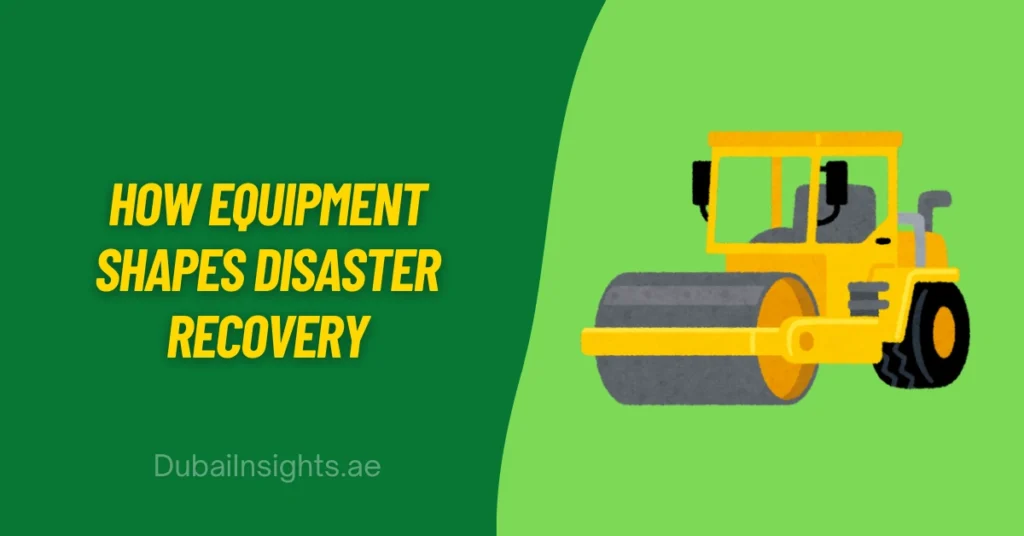How Equipment Shapes Disaster Recovery
When disaster strikes, recovery depends on the equipment used. Long before reconstruction teams arrive, the first machines on site begin the work of restoring order. The sight — for example — of a road roller compacting washed or churned earth is a small but decisive signal: routes are being stabilised so aid can move. Equipment does not merely support recovery; it defines what recovery can achieve, how fast it arrives, and how durable it will be.

The urgency of machines in the immediate aftermath
Clearing access, stabilising ground, and shoring temporary shelters are urgent tasks. Heavy equipment reduces time-to-access for lifesaving supplies and medical teams, and it shortens the window during which people remain isolated or exposed. Relief agencies stress that machinery and logistics form the backbone of disaster response, not a secondary concern. Clearing routes quickly turns disorder into access, giving aid teams a path to shift from temporary fixes to steady rebuilding.
Groundwork first: stabilising routes and sites
Before permanent repairs begin, the ground must be reliable. Floods scour roadbeds; earthquakes fracture subgrades; storms leave soft, unstable surfaces. Restoring these surfaces is a core priority because all further work depends on them. Road rollers recompact damaged embankments and repair layers so relief trucks can reach hospitals, supply hubs and work sites. In major disasters, assessments show road and bridge repair is one of the first and most valuable investments, since access supports every other part of recovery.
Versatile machines that work where bigger gear cannot
Disaster sites are seldom ideal work yards, they are tight or unstable areas, large excavators and cranes cannot operate effectively. Compact machines fill the gap. The skid steer loader, with its small size, mobility and flexible attachments, allows crews to clear rubble, move debris, reopen paths and carry out quick repairs. Manufacturers and field reports from recent responses describe skid steers deployed for debris clearance, for moving building elements, and for preparing sites for emergency shelters — roles that significantly cut manual labour time and speed up reopening of neighbourhoods.
Precision rebuilding: why compaction and small-scale tools matter
Once access is restored, reconstruction requires careful preparation. Rebuilt foundations, temporary housing pads, repaired pavements and restored service trenches all depend on correct compaction and surface preparation. While large rollers prepare broad routes, smaller machines ensure stability where space, geometry, or sensitivity make large rollers impractical. Plate compactors are the tools that provide this final control: they consolidate base layers, remove voids beneath paving units, and secure trenches around pipe repairs. Proper compaction reduces settlement, prevents early failure, and protects restored services from repeat damage. Industry handbooks and field guides underline that compaction — and the tools that achieve it — determine whether a repaired asset lasts or quickly requires additional repair.
Sequencing: how the right equipment changes the programme
Recovery is not a single activity but a sequence: clearing, stabilising, temporary works, and permanent rebuilding. Each phase calls for specific plants and attachments. Quick clearance with skid steer loaders and excavators opens routes; road rollers then stabilise and reinstate circulation; plate compactors finish smaller areas to the tolerances required for pavements and utilities. Using the correct machine at the right stage shortens the programme and reduces secondary damage caused by premature traffic or poorly compacted backfills. That sequencing is simple in principle but complex in practice — it depends on logistics, equipment availability, and operator skill.
Logistics and human factors: machines must arrive ready to work
Transporting equipment into a disaster zone is often the main constraint. Relief organisations and national authorities therefore emphasise two parallel investments: rapid logistics for plant delivery, and trained operators able to adapt machines to unpredictable terrain. Case studies of major responses repeatedly show that coordination between agencies, contractors, and local authorities determines how effectively equipment actually speeds recovery.
Equipment choices affect resilience and long-term cost
Selecting the wrong scale of plant or skipping precision tools can appear to save time and money early on, but it often increases lifetime cost. Poor compaction leads to settlements, weak roadbeds fail under heavy use, and ad-hoc fixes require repeat work. Conversely, an initial investment in correct machinery — from rollers that restore road profiles to plate compactors that finish paving around utilities — reduces recurrent repair needs. Donors and asset owners who evaluate whole-life costs (not just immediate outlay) consistently find that the right plant mix during recovery improves long-term resilience.
Conclusion
Disaster recovery depends on the right mix of machines at every stage. Road rollers restore access routes, skid steer loaders clear and prepare sites, and plate compactors secure the final layers for stable foundations. Together they turn short-term repairs into lasting recovery.






